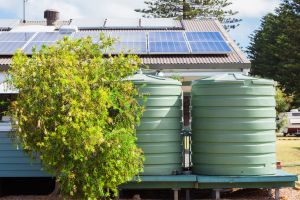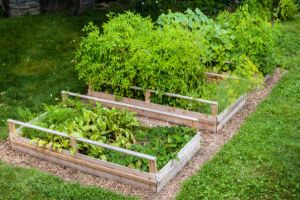Growing a survival garden has become a staple of prepping.
When we realize that any long-term or TEOTWAWKI event that comes along is likely to far outlast our food stockpile, no matter how big it is, it doesn’t take much to convince us of the need for a survival garden.
The big problem for most of us though, is having enough room to plant that garden. Added to that, is the challenge of keeping your garden from prying eyes.
Let’s face it, it’s almost impossible to hide what we’re doing from our neighbors; especially if they happen to be nosy ones.
Most people are curious enough that they pay attention to what’s going on at the house next door. If what’s going on looks interesting, they pay even more attention. That makes it hard to hide a garden from their curiosity.
Adding to that is the problem of space. It takes a large garden to feed your entire family, especially if you consider that you need to grow enough to get through the entire year.
However, with this guide, you can become self-sufficient, even with a small yard. It’s designed for a quarter-acre setting, with the objective of achieving total self-sufficiency for a family of 4, and having goods to sell. But it was created in such a way that it is easy to downsize if you have less land or fewer family members.
While raising your own vegetable garden isn’t exactly commonplace, it’s not so strange as to make anyone draw the conclusion that you’re a prepper. There are still people today who raise their own vegetables, but aren’t counted amongst the ranks of the prepping community.
Nevertheless, it’s highly likely that those neighbors will remember your garden when food runs out and they want something to eat. That’s when they might be tempted to slip over the fence and see what you have that they can reappropriate for their own use.
This makes it so that the real trick about growing a survival garden is keeping your garden from being obvious. As an alternative, some parts of your garden might end up being obvious, but you’ll want to make sure that not all of it is readily identifiable as a vegetable garden. The more of your garden that you can keep people from recognizing for what it is, the better.
Related: 6 Signs Your Neighbor Will Become A Looter As Soon As SHTF
Fortunately for us, most people don’t know what they’re looking at, when they look at garden plants. Oh, they’ll recognize tomatoes growing on your plants, but they’re unlikely to recognize a potato plant. If you can manage to keep the melons hidden, they won’t recognize a watermelon or cantaloupe vine either.
Deception Is Your Friend
 If you want to live the life of a self-sufficient prepper, without people realizing what you’re doing, then deception has to become part of your plan.
If you want to live the life of a self-sufficient prepper, without people realizing what you’re doing, then deception has to become part of your plan.
I’ve planted food, built both a wind turbine and solar panels, put in rainwater capture with some massive water tanks and other projects at my home.
As far as my neighbors are concerned, I’m just an eccentric former engineer, who likes to experiment.
When it comes to your gardening, it’s easy to come up with excuses. You might say that you don’t trust GMO produce. Perhaps you prefer the taste of vegetables that are freshly picked off the plant. Your family may have a tradition of canning your own.
You can even say that you just want to try some of the more unusual varieties of vegetables, which aren’t available in the store. Any excuse will work, just as long as you make it plausible and carry through with it. This way, they can see you doing what you say.
One of the more effective ways of growing vegetables in a way that doesn’t look like you’re growing veggies is to plant them randomly. People are accustomed to seeing vegetable gardens planted in rows, whether that is in raised beds or in a ground-level garden.
Planting your veggies randomly, mixed in with other plants, plays tricks on their mind, making them think that what they’re seeing is a decorative garden, rather than a vegetable garden.
Start with Your Regular Garden
 The starting point for any survival garden is the most obvious part, regular raised beds for planting.
The starting point for any survival garden is the most obvious part, regular raised beds for planting.
While you’re making your raised beds, take the extra time to make a greenhouse for them.
Related: DIY Poor Man’s Greenhouse
This can be made of PVC pipe and clear plastic sheeting, which really isn’t clear.
If you live in a temperate or colder climate, the greenhouse can be explained away as a means of growing plants before the weather gets warm enough for your flowers to grow. Make sure that they see you bringing flowers out of your greenhouses from time to time, to substantiate that story.
Other than the flowers you’re going to plant in your regular garden as camouflage for your veggies, you mostly want to plant things that will be easy for people to identify.
This is the place to plant your tomatoes and peppers, both of which are extremely obvious, once they begin to bear fruit. But people won’t recognize the fruit, if they can’t see it.
You can also use this easy guide to build a hidden food growing fence. This way you can turn an idle fence into a hidden but bountiful garden. You can make it from wooden planters or even discarded pallets. Even people who pass by, looking over the fence would not see it.
Decorative Planting in Plain Sight
Most people have some sort of garden in their front yard, mostly flower beds along the walkway and up close to the house.
Rather than planting flowers in these places, plant green, leafy plants that are native to your area. Ideally, plants which will require minimal watering. This is called “xeriscape” gardening and it has become quite popular, especially in more arid regions of the country.
 Since you’ll be growing mostly leafy plants, rather than flowing ones, it’s easy to add in other leafy plants, without people recognizing them.
Since you’ll be growing mostly leafy plants, rather than flowing ones, it’s easy to add in other leafy plants, without people recognizing them.
Specifically, this is a great place to plant root vegetables, like potatoes, onions, garlic, carrots, turnips, beets, radishes and sweet potatoes.
Just make sure that when you harvest, you don’t leave anything behind for your neighbors to dig up, thinking you’ve left food there for them.
Plant a Garden Forest
Another useful trick for hiding your fruit and vegetable bearing plants is to hide them in the midst of a ‘forest.” Granted, you probably can’t plant an actual forest on your property, unless you have a lot of land; but you can plant a garden in a forest-like way.
If you think of any forest you’ve ever seen, the predominant foliage is the trees. Tress will be scattered around, randomly, with at least some space between them. Sometimes, there will be larger trees growing, with smaller ones in-between.
These may be of the same species or different ones, depending on the forest. What’s important though is that they are trees which will probably not grow to the full stature of the mature trees.
Between all those trees, you’ll find both bushy plants and smaller ones. Often, the busy plants will be growing up close around the tree trunks, with the other plants growing outside the bushes. This gives any forest a “three-dimensional” growing pattern which we can make use of.
What you want to do, to reproduce this in your own backyard, is to start out by planting trees, preferably fruit trees, which will provide you with food. Rather than planting those trees in rows, scatter them out, so that as they grow, it will look more like they grew there naturally.
With the trees in place, as the anchor for your garden, you can start planting a combination of vegetables, berry plants, melon vines and some leafy greens. As with the tree planting, make your pattern random, so that it looks like the various plants just grew there naturally, rather than as a planned garden.
When people see it, they won’t see the forest, for the trees. Put another way, they are likely to overlook the vegetables growing in your yard, because their attention will be fixed on the overall affect of how your “forest” looks.
You may also like:
 6 Mistakes You Are Probably Making When Buying Your Guns
6 Mistakes You Are Probably Making When Buying Your Guns
How to Make Your House Invisible to Looters (Video)
Chicken Mistakes You Should Never Make






















The garden area we have is small enough for a extra amount of food. Not enough to sustain for a year’s worth, it supplement us for a week if conditions are good. There is a constant battle with mice, rats, raccoons and occasional coyote munching the garden.
It gets too costly to use hardware cloth to surround the main garden. The dam environmentalist and union vegetarian climate freaks have gotten the politicians to ban the use of chemicals to use against rats and mice.
These indoctrinated college students think everything is bad to use these days.
I can agree to much poison rat, mice bait is not good for the natural predators. The hawks, cats, dogs and back yard chickens can suffer from ingesting a poison bait rat or mice.
There has too be a happy medium for us humans to have something to eat in this crazy Bidenomics era we have.
Try corn meal mixed with plaster of Paris 60/40 to 50/50 ratio put into a length of 3″ or 4″ dia. 6″ long metal vent pipe closed on one end, this should keep the chickens and dogs away and place a pan of fresh water near the bait. I learned this trick years ago from an old neighbor and have used it from time to time. RS
Brian, look up YouTube videos on killing mice/rats with a combo of dry Jiffy cornbread mix and baking soda. I see others have already posted this. Mice and rats can’t expel gas (they can’t burp or “pass gas.”) They scarf down the yummy mixture, and then the baking soda reacts with the acid in their stomachs, which creates gas bubbles. Their stomachs swell up and they die. You don’t have to worry at all about cats, dogs, or wildlife being poisoned by eating rodents that died this way. And as mentioned, there are several variations of this idea, like using packets of hot chocolate mix…..apparently the little rascals are chocoholics!
Good luck!
There is a constant battle with mice, rats, raccoons and occasional coyote munching the garden.
============================================
Try this & it’s a proven fact if you have a mouse, you can prove it to yourself.
Peppermint leaves or peppermint oil is toxic to anything in the rodent family. It will evaporate rapidly, so mix into soap and place in an ice cube tray when they harden, place around / in the garden. Also mix it with water in a spray bottle & spray around as needed, after 2-3 times mice etc. learn and don’t come back. Coyotes just have a male adult pee around the area, and the male-alpha pheromones will keep them away.
Is this article what some survivalist elude to as Guerrilla gardening?
I have seen the term used in some obscured reference but not truly known what the term means in application.
To have a garden in plain sight but slightly camouflage by objects like bushes, trees, that blur the goodies from stealing the food?
When my sister bought her house I gave her some blueberry plants for the front yard. No edible plants are allowed by homeowner association rules. It worked because the city people did not know that blueberries grow in clusters like grapes. There is a book called Edible Landscaping. It has some really good ideas.
It’s a food forest model of planting…and planning…and it has been called guerilla gardening, tho that one has other connotations–like planting a hellstrip between the sidewalk and street, or tossing grass, flower and other seeds into a vacant lot. If you look at a forest, you see the canopy of trees, smaller trees underneath, shrubs and bushes underneath, herbs and ground cover next and vining plants to climb the trees or shade the soil around the trees and plantage.
For ours, we do fruit trees, blueberries or sage varieties (you can also go with basil, oregano or other producing herbs or berries) underneath, varieties of chives and thyme around those, and melons or cukes or mini-pumpkins around that. Living in a yuppie suburban neighborhood, we obscure our edibles A LOT. Granted, the yuppies rarely know what they’re looking at, even a real tomato vine–with tomatoes on it…
I too would like to know what a hidden garden is all about.
I have seen different explanations of guerrilla gardening on websites, is this a generic term used?
Guerrilla gardening is the practice of planting flowers or edible plants in neglected private or public spaces.
Don’t remember the exact article on the camouflaging of gardening. This guy said you can have a garden hidden anywhere at your home. Even in the front yard by disguising or using edible plants in various ways. Not planting carrots and onions on the front property.
But use edible bushes that most people walking by the home don’t recognize right away as a food source.
He says plant the vegetable garden in back of the house to avoid a nosy overly inquisitive person.
Are there other websites preppers have found that show how to do a Guerrilla garden? It sounds interesting in these crazy times to hide our food.
It’s called a food Forrest. It does not look like a traditional farm or garden, just another house from the road.
This is for people who have some land, not in the suburbs.
I like to learn about ways to prep and be ready for what ever happens. I must be the most impatient prepper. When I read every one of the tips that is posted in these messages. It has the long paragraphs about the history of the world before we get to the actual information. Maybe have bullet points of your tips then a link to the history of the topic dating back hundreds of years if the reader is interested? Thank you for all you do.
Remember plants are great if they dont distract, draw attention and look like they are misfits of the garden
very important to cultivate a protection grid of natural plans which are native to the area
also burms which allow natural barriers to the area
every stop gap is a slow down zone for reaction time
this cause s second thought and moves the incoming targets away from an area
with the advent of drones and other IR, whitelite technologies , it important to have multiple layers of different types of trees, plants , bush’s to slow down the incoming idiots who beleive in no self control , no restraint , no respect for others ,and what does not belong to them .
Always ready , be prepared , and take nothing for grantit
I think what Chris said was very wise and good counsel to follow.
Think in terms of choke points where it slows down and contains the adversary in a confined area in order for you to take more effective action if necessary.
Hard to plant in forest around here as most things planted would require fencing or the deer, birds, or other animals would eat your crop. GOT forest, but fence kind of stand out.
Rosemary repels deer, they hate it.
Birds are another thing but it can be done, there is bird repellent or birds of prey or just bird netting. Another thing is lines of string with red pennants, when the wind blows it moves the pennants, scaring away the birds.
Aquire seeds that reproduce themselves, no hybrids. Store them in ammo boxes and have at least three years worth just in case. Plant enough for the critters, you will eat the critters eventually. Rats cannot vomit, so mixing bird seed and plaster of Paris 50/50 will do them in and won’t affect their meat. Don’t foresee drivebys save for government vehicles. Neighbors will really appreciate dented, outdated, and questionable canned goods. Don’t forget to study up on edible greens. Buy salt and canning lids. Dead looters don’t cause any problems.
Your best place to store seeds is in the fridge. I worked for a wholesale seed company and this is SOP. I have tomatoes growing from 4 year old seed now.
We have a deep, tall flower garden along the perimeter of our lawn & our veggie set-up is behind the tall flower garden, in plain sight, but hidden & somewhat protected by tree canopy. Veggie-snatchers would have to walk under our night light & through a trellss to get to our veggies. And we have a battery-operated alarm across our driveway that is LOUD. Cattle-fence gates, yet we are surrounded on three sides by thick pine forest so still accessible to the desperate . . . sigh. We designated one half-barrel tub of tomatoes close to the front gate to let the snatchers steal those veggies while we got locked & loaded. Rural SC here, dirt road, poor lighting, no law ‘cept us.
DRae, love the idea of having a few easily visible and accessible tomato plants to sacrifice to veggie thieves!
We have a tower garded. OK,OK I know about electricity. We live on an island where it’s dicey often enough & until we aged out, lived off the grid about 9 months each year.
But, the thing uses an aquarium pump. We live in a raised house and the thing sits on the porch. Our climate is such that we can used it except in high summer. It provides enough produce for us to have at least some fresh, healthy food daily.
One of our rain barrels can be moved up to the back porch and hooked up to the downspout there, for security.
Of course on our islands “looters will be shot. Crabs have to eat, too.”
There are way too many critters in our yard to hope for us to get much and them to get more. We could grow in dirt pots on the porch. Nothing is perfect.
I meant GARDEN.
Thank you for this article. I opened my email up and found this. I never even thought about it like this. Although this year the city was called on me for ” weeds”. I had explain to the inspector they are native wildflowers and perfectly legal to grow. He attempted once again to down size me and I told them they are part of my food source. In this economy I try to reduce my food bill as much as I can. Then he complained about my ” volunteer trees ” . Which are really blackberry and gooseberry bushes( all trimmed and propped up with support). The only thing he had to say after that was, ” what’s under the deck in the bags?” I said he should probably not open those it’s my compost. He said I have to put it in the ground. So I did. Then I got a call about the smell. I told him he ordered me to do it after I told him I wait until the second frost, to be nice to the neighbors, because it does not smell to pretty. He actually laughed and said , ” well I guess you are paying back the jerk of a neighbor then. They call us on you quite often, what did you do to them?” I told him the truth, which was, ” I refuse to mow their lawn for free or shovel their snow for free because they keep calling the city on me for nothing.” He had a belly laugh and told me to have a nice day.
So do be careful how you plant, a lot of dummies will think you are growing weeds.
Consider planting sunchokes, A.K.A. Jerusalem Artichokes. Native to North America, look like sunflowers so no reason for thieves to know that the tubers are a healthier replacement for potatoes. Almost no care required except for watering. Planted by native Americans along migration trails to have something to eat when following buffalo herds.
Plant food plants that don’t like like common foods. Not only sunchokes but bulbs such as lilies and elephant ears l. Also yucca. You can seed nearby wet spots with cattails and seed woods by throwing out fruit seeds or Vining seeds into nearby wooded areas.